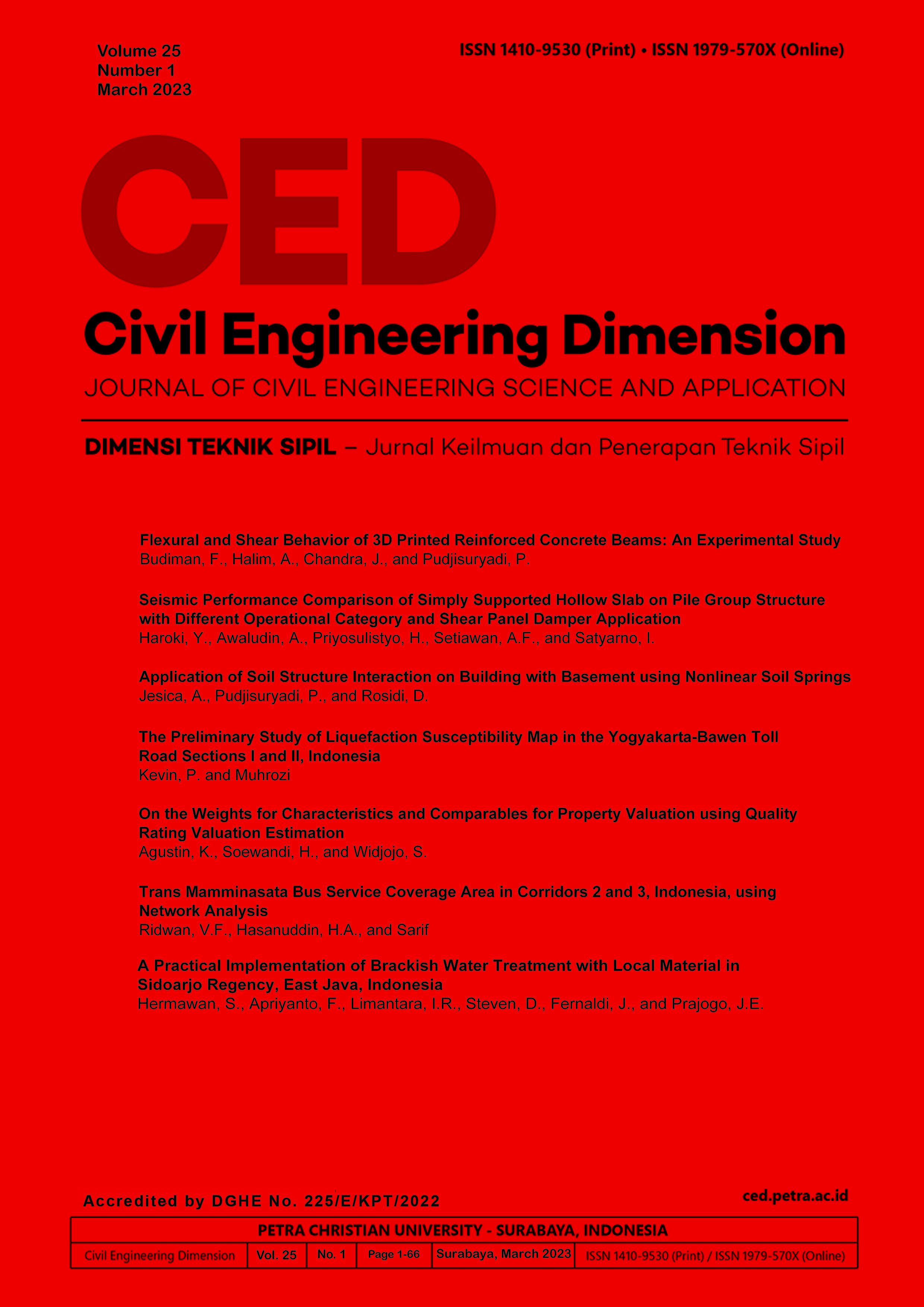Seismic Performance Comparison of Simply Supported Hollow Slab on Pile Group Structure with Different Operational Category and Shear Panel Damper Application
DOI:
https://doi.org/10.9744/ced.25.1.10-19Keywords:
Numerical model, prestress effect, nonlinear time history analysis, energy dissipationAbstract
This study is aimed to compare the seismic performance of simply supported hollow slab on pile group (SHSPG) structures designed as “critical” and “essential” viaducts with shear panel damper (SPD) devices. There were three numerical models to be compared, namely SHSPG-A, SHSPG-B, and SHSPG-C. SHSPG-A is a “critical” viaduct with 35 piles per one pile head. SHSPG-B is an “essential” viaduct with 18 piles per one pile head. SHSPG-C is an “essential” viaduct with 18 piles per one pile head plus sixteen SPDs. Numerical models considered the prestressing effect of the spun pile. Nonlinear time history analyses were executed using seven pairs of recorded ground motions that had been scaled and adjusted to the seismic characteristics of Yogyakarta, Indonesia. As the result, the performance level of SHSPG-A was much better than SHSPG-B. The SPDs application could maintain SHSPG-C’s performance at the same level as SHSPG-A and dissipate 34.28%-53.03% of the seismic energy.
References
Yeung, A.T., Installation of Prestressed Spun High Strength Concrete Piles by Hydraulic Jacking, in The HKIE Geotechnical Division Annual Seminar, 2014, pp. 109–115.
Budek, A. M., Benzoni, G., and Priestley, M.J.N., Experimental Investigation of Ductility of In-Ground Hinges in Solid and Hollow Prestressed Piles, Structural Systems Research Project, University of California, San Diego, 1997.
Irawan, C., Djamaluddin, R., Raka, Faimun, I.G.P., Suprobo, P., and Gambiro, Confinement Behavior of Spun Pile Using Low Amount of Spiral Reinforcement - An Experimental Study, International Journal Advenced Science Engineering Infrastucture Technoly, 8(2), 2018, pp. 501–507, doi: 10.18517/ijaseit.8.2.4343.
Setiyono, U. et al., Katalog Gempa Bumi Signifikan dan Merusak 1821-2018, 1st ed. Jakarta Pusat: Pusat Gempa Bumi dan Tsunami BMKG, 2019.
Darmawan, M.F., Pile-Supported Slab Viaduct Structure Braced With Shear Panel Damper, Universitas Gadjah Mada, 2021.
Xu, L.Y., Nie, X., and Fan, J.S., Cyclic Behaviour of Low-yield-point Steel Shear Panel Dampers, Engineering Structure, 126, 2016, pp. 391–404, doi: 10.1016/j.engstruct.2016.08.002.
Yang, L., Gao, Y., Shi, G., Wang, X., and Bai, Y., Low Cycle Fatigue Property and Fracture Behavior of Low Yield Point Steels, Construction Building Material, 165, 2018, pp. 688–696, doi: 10.1016/j.conbuildmat.2018.01.075.
Abebe, D.Y., Kim, J.W., Gwak, G.,and Choi, J.H., Low-Cycled Hysteresis Characteristics of Circular Hollow Steel Damper Subjected to Inelastic Behavior, International Journal Steel Structure, 19(1), February 2019, pp. 157–167, doi: 10.1007/s13296-018-0097-8.
Menteri Perhubungan Republik Indonesia., Persyaratan Teknis Jalur Kereta Api. Jakarta: Menteri Perhubungan Republik Indonesia, 2012.
BSNI., Perencanaan Jembatan Terhadap Beban Gempa SNI 2833, Jakarta: BSNI, 2016.
AASHTO., AASHTO LRFD Bridge Design Specification. 2012.
Kent D.C. and Park, R., Flexural Members with Confined Concrete, Journal Structure Division, 97(7), 1971, doi: 10.1061/JSDEAG.0002957.
The European Union., Eurocode, 8(8). 2011.
Furuta, T. and Araki, S., The Horizontal Deformation Characteristics of Natural Rubber Bearing by FEM Analysis, in 13th World Conference on Earthquake Engineering, 2004, 78, pp. 41–49, doi: 10.5459/bnzsee.38.1.41-49.
Han, X., Kelleher, C.A., Warn, G.P., and Wagener, T., Identification of the Controlling Mechanism for Predicting Critical Loads in Elastomeric Bearings, Journal Structure Engineering, 139(12), 2013, pp. 1–12, doi: 10.1061/(asce)st.1943-541x.0000811.
Shi, G., Gao, Y., Wang, X., and Zhang, Y., Mecha¬ni¬cal Properties and Constitutive Models of Low Yield Point Steels, Construction Building Materials, 175, 2018, pp. 570–587, doi: 10.1016/j.conbuild-mat.2018.04.219.
Chen, Z., Ge, H.,and Usami, T., Hysteretic Model of Stiffened Shear Panel Dampers, Journal Structure Engineering, 132(3), 2006, pp. 478–483, doi: 10.1061/(asce)0733-9445(2006)132:3(478).
Chen, Z.Y., Chen, W., and Bian, G.Q., Seismic Performance Upgrading for Underground Structures by Introducing Shear Panel Dampers, Advanced Strucural Engineering, 17(9), 2014, pp. 1343–1357, doi: 10.1260/1369-4332.17.9.1343.
Setiawan, A.F., Development of High Seismic Performance Ingegrated Bridge Pier Connected by Hysterical Damper, Kyoto, 2018.
Setiawan, A.F., Takahashi, Y., and Sawada, S., Development of a Shear Panel Damper Plus Gap, Journal JSCE, Under Review, 2018, pp. 1–13.
ASCE., Minimum Design Loads and Associated Criteria for Buildings and Other Structures. Structural Engineering Institute of the American Society of Civil Engineering, Reston, no. 7 98. Virginia: American Society of Civil Engineers, 2013.
Sunardi, B., Percepatan Tanah Sintetis Kota Yogyakarta Berdasarkan Deagregasi Bahaya Gempa, Jurnal Lingkungan dan Bencana Geolo¬gy, 6(3), 2015, pp. 211–228.
ASCE and COPRI., Seismic Design of Piers and Wharves. Virginia: ASCE, 2014.
Uang, C. and Bertero, V.V., Evaluation of Seismic Energy in Structures, Earthquake Engineering & Structural Dynamics, 19(1), 1990, pp. 77–90, doi: 10.1002/eqe.4290190 108.
Kalkan, E. and Kunnath, S.K., Effective Cyclic Energy as a Measure of Seismic Demand, Journal of Earthquake Engineering, 11(5), 2007, pp. 725–751, doi: 10.1080/13632460601033827.
Downloads
Published
How to Cite
Issue
Section
License
Copyright (c) 2023 Yusuf Haroki, Ali Awaludin, Henricus Priyosulistyo, Angga Fajar Setiawan, Iman Satyarno

This work is licensed under a Creative Commons Attribution 4.0 International License.
Authors who publish with this journal agree to the following terms:- Authors retain the copyright and publishing right, and grant the journal right of first publication with the work simultaneously licensed under a Creative Commons Attribution License that allows others to share the work with an acknowledgement of the work's authorship and initial publication in this journal.
- Authors are able to enter into separate, additional contractual arrangements for the non-exclusive distribution of the journal's published version of the work (e.g., post it to an institutional repository or publish it in a book), with an acknowledgement of its initial publication in this journal.
- Authors are permitted and encouraged to post their work online (e.g., in institutional repositories or on their website) followingthe publication of the article, as it can lead to productive exchanges, as well as earlier and greater citation of published work (See The Effect of Open Access).











